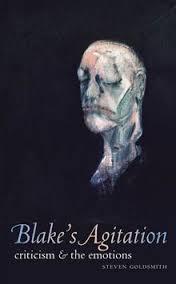Blake's Agitation: Criticism and the Emotions by Steven Goldsmith

For the title page of William Blake’s Milton, the poet engraved an image of his hero, naked and with his back turned, wiping away the printed letters of his name as he emerges facing a light between dark, swirling clouds: “To step out of heaven is to make oneself vulnerable to revision,” explains Steven Goldsmith in his analysis of the engraving in Blake’s Agitation: Criticism and the Emotions. When Goldsmith, a Professor of English, returns to Blake's epic on an imaginary encounter with Milton in his last chapter, he concludes that “whatever freedoms are revealed by the magical world at the end of the first book of Milton are freedoms our feelings have put there.” This endorsement of readerly emotion is hard-earned. Tracing eighteenth-century theories of sentiment through the more recent scholarly interest in "emotional intelligence," Goldsmith asks whether our enthusiasm for emotion ought to be trusted. If Blake had set out to fulfill the task he identified with Milton – to sustain the possibility of world transformation in the aftermath of a failed revolution – Goldsmith in turn takes on the task of assessing both Blake's ambition and the viability of his insight for critical activity in our age.
Such reflective scrutiny befits a reader of Blake, who is as equally a master of suspicion as he is a poet of prophetic visions. Blake’s aesthetic is marked by agitation - both of sentiment and politics. His poetry also harkens, as Goldsmith shows, to agitation’s older definition as the vital movements of living organisms. In conjunction, Goldsmith points out a recurring motif in philosophy: revelation as an embodied experience. A few of his examples include Jameson’s description of dialectical self-consciousness as “a sickening shudder we feel in an elevator’s fall”; Lyotard’s sense that the sublime is “an eloquent silence...a feeling that is always an agitation”; Derrida’s notion that decision is “the other’s heartbeat” one “receive[s] in a rhythmic pulsation”; Sartre’s definition of emotion as nothing less than “a transformation of the world,” a “seizure of new connections and new exigencies." Locating agency in such “affective texture of critical thought,” Blake’s Agitation seeks to draw attention to the transformative capability of the material, bodily response that reading can elicit.
Despite the intimacies his work invites, Blake was a strangely anonymous figure. A poet of revolutionary philosophy who led a quiet, upwardly mobile life uninvolved in any organized movement, he nevertheless insisted on adopting an oratorical poetic voice, addressed to an absent public. Goldsmith accounts for the “paradox of Blake’s public individual” by reading Blake’s poetry and engravings through his contemporary Immanuel Kant, specifically the German philosopher's later political treatises. “Lyotard’s Kant,” as Goldsmith refers to him, places the historical agency of the French Revolution in the nonparticipant spectators, who only look on and exercise critical judgment. Their reading can entertain possibilities of a revolution unbound by its present realization, pointing up “a future that the event has not yet encompassed.”
This paradox of public consciousness voiced by those not necessarily representative of the public is what is at stake in Goldsmith’s project. He admits frankly that “there are reasons not to trust the emotions central to our work” (the “we” here referring directly to Goldsmith’s fellow teachers, scholars and students who “may secretly harbor” hopes that “our work will teleiopoetically find some future audience or some future resonance we cannot currently anticipate”). Yet Goldsmith also affirms throughout that “the answer can only be ‘yes.’” The demand he places on critical reading is precisely to keep incommensurate positions suspended in a state of constant negotiation: to be agitated, to cause agitation.
There are several scaffoldings to the arguments made in Blake’s Agitation. Part One, “Devil’s Party,” unpacks the role emotion plays in Blake’s works, paying particular attention to his engagement with Milton. Part Two, “A Passion for Blake,” first maps out the logic underlining various strands of recent scholarship on affect. A deceptively simple poem, “On Anothers Sorrow,” and its rhyming of grief/relief anchor a discussion of sympathy and the urgency of commitment in literatures and theories of emotion. The book ends by reflecting on Blakean claims of agency and the possibility of freedom made by a set of key contemporary and twentieth-century critics.
Visit the Biblio-file to view the books that shaped Professor Goldsmith’s ideas while working on Blake’s Agitation.